RIVE may be an unusual swan song for Two Tribes, the developers of Toki Tori and several other great puzzle games, but this explosive action platformer easily meets the high mark of quality set by its predecessors. Taking place in and around an abnormally deadly space facility, RIVE is a passionately blatant love letter to the sidescrollers and shmups of yesteryear and it is jam-packed with a menageries of over-the-top set pieces alongside a brutally high difficulty curve. With hundreds of robots to destroy and dozens of ways to be crushed, smashed, burnt to ash, and ripped apart, this is one game which does everything it can to live up to its name.
There’s more going on here than RIVE initially hints at so it’s honestly somewhat difficult to decide just where to begin, but the best place may be at the start of the campaign. Everything begins from the first person view of our toothbrush-wielding space scavenger protagonist, Roughshot, as he logs in to his ship, switches the perspective to outside of the ship by turning on sidescroller view, and turns on “some classic game music” as he shoots asteroids and robots alongside the hull of a much larger ship. This is certainly a nostalgic type of scene, but the presence of your ship’s machine gun turret, which can be aimed in 360 degrees with the mouse (or the right analog stick), alongside the modern aesthetics quickly dispels any fears of RIVE banking on empty nostalgia. Of course, this trip through an asteroid field turns out to be only the first set piece of many as you soon fly through a set of doors and land on the ground as gravity returns.
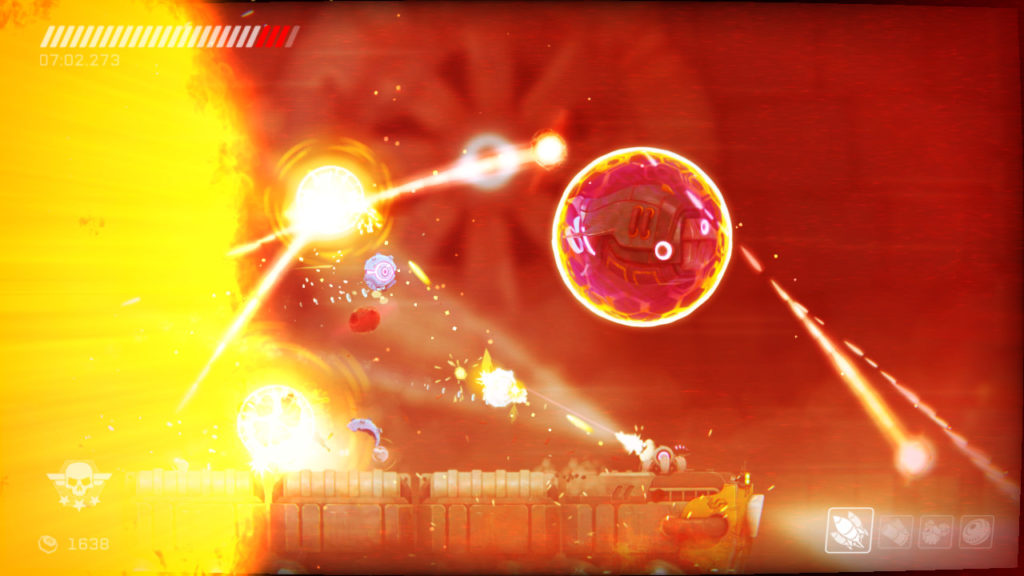
The game wastes no time when it comes to introducing players to many of its elements. As gravity returns and you adjust to having free movement and a double jump you are greeted by a friendly flying robot, later revealed to be named DLL, whom you can choose to listen to for a while or you can just blow apart a few copies of him before he gives up on having a conversation, but either way it results in the next door being opened. Within the next five minutes the game rapidly introduces the hacking beam, a short-range beam which can be used on panels to open doors or operate other machinery, warp points, an upgrade machine where you can initially choose between two different special weapons to buy with scrap parts gained from enemies, ammo crates for these special weapons, and even a fight against a miniboss. It’s a fair amount of stuff to take in, but all of it is very simple and the lightning-fast pace never slows down for more than the briefest of moments.
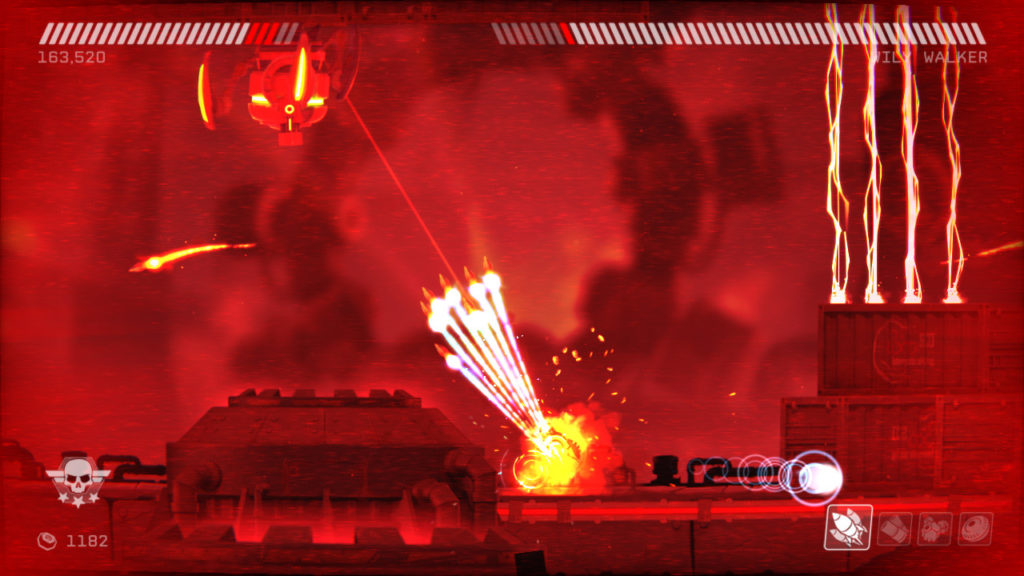
The abilities at your disposal consist solely of the machine gun, up to four special weapons from the upgrade machine, the hacking beam, and a double jump, but the gameplay never comes close to getting stale as the rules constantly change. In addition to opening doors, you gradually gain access to being able to take over different types of enemy units to help you with the hacking beam, such as healing drones and turrets. Gravity is also in a precarious position as some parts of the ship allow for entirely free movement and most levels have at least a few ‘gravity bubbles’ which you can move around freely within and which you’ll need to jump between. Water also adds a new twist to the gameplay as your weapons can’t fire while you’re submerged, forcing you to utilize hacked turrets or to shoot while jumping above the surface before diving back down. There’s also a good amount of variety to the level design as you quickly move between confining pipes, vertical corridors, sections with have autoscrolling in one form or another, and enormous rooms. Progression is linear, but you’ll backtrack to various parts of the ship, sometimes within the span of a few minutes and each room is never the same twice as doors will close, lasers might fly in, and suddenly a whole host of new hazards will create a makeshift arena in which you’ll need to fend off increasingly dangerous waves of enemies; you gain a feel for the layout of the ship as the game progresses and you still won’t ever know quite what to expect each time you return to an old location.
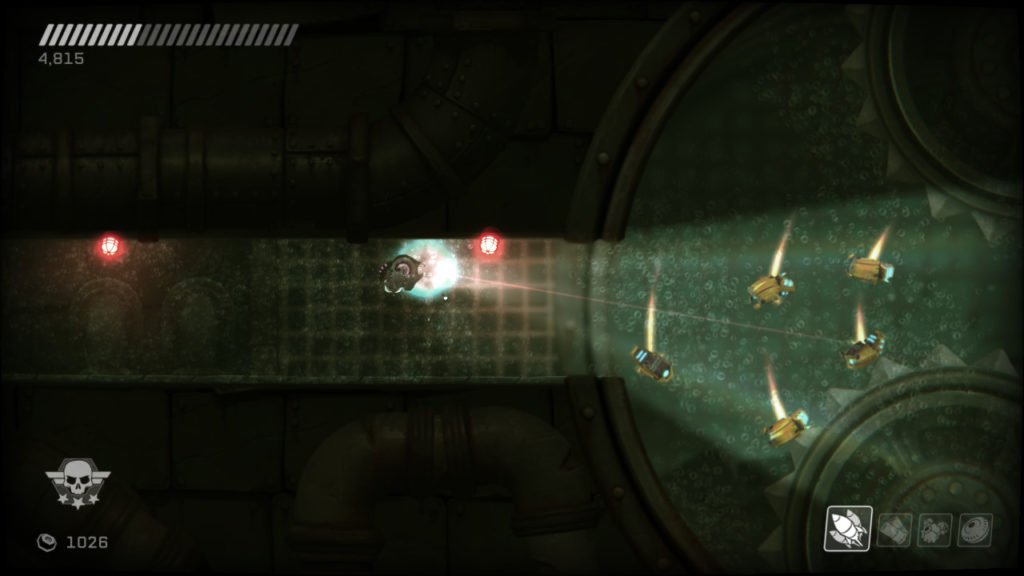
The pacing here is blindingly fast in every regard. Combat is quick and brutal as your weaponry can annihilate swarms of enemies in a flash and your own ship can only take a handful of hits before exploding. All four special weapons share the same ammo and you can only carry a single piece of special weapon ammo, but enemies also frequently drop ammo and healing items, allowing you to easily fire off special attacks one after the other as you sit on a pile of ammo crates. Even when not in combat you are encouraged to never stop shooting as lights, traffic cones, crates, and other objects are scattered about which can add to your score and help to maintain a multiplier for the online leaderboards. Almost the entire game is made up of memorable set pieces which are simultaneously visually stunning and highly challenging, such as fighting an enormous enemy-spawning robotic sky whale while jumping over even larger balls of fire or dodging lasers as enemies pour into the room while you also dodge trains and watch enemies get smashed to pieces. The aesthetics also go a long way with a large and energetic soundtrack, all sorts of explosions, and tons of small touches like individual bullet shells from your machine gun shots floating next to you while firing from within a gravity bubble. Death comes quickly and often, but extremely generous checkpointing with no penalties outside of losing some time bonus points helps to maintain the pace with a new checkpoint after every challenge and even one or two checkpoints in the middle of some of the more extensive enemy gauntlets.
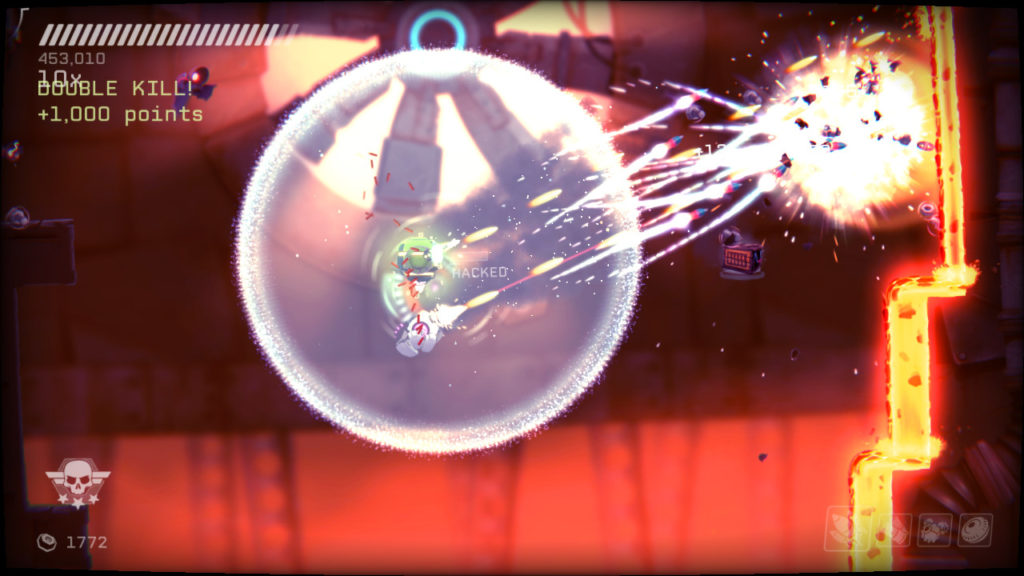
With so much variety within the campaign itself, it’s only appropriate for this sense of variety to spill over into the rest of the game as well. There are two difficulty settings, Hard Mode, which is actually the original difficulty and is directly stated as being the way the game was intended to be played, and Normal Mode, which is an easier difficulty added in after launch and difficulties can be swapped between at any time. Individual levels can be replayed at any time after beating them in the campaign and you always have every special weapon and both purchasable health upgrades when replaying these. Both the individual levels and, after beating it, the whole campaign have three different modes to play through them in for the sake of the leaderboards: Regular Mode tracks points based on time and various kill modifiers, Speedrun Mode only tracks time taken, and Single-Credit Mode doesn’t let you continue if you die. On top of this, there are also 18 challenges to complete, such as surviving for several seconds while fighting enemies on a conveyor belt or killing 42 cockroaches in under a minute, and these each also have their own leaderboards. These challenges take place in locations from within the campaign, but modify them enough to feel different from their original incarnations and each challenge increases in difficulty from Bronze to Silver to Gold, which does lead to one of the very few questionable design decisions in this game as you must wait a day after completing the newest challenge on Bronze before the next challenge in the list will permanently unlock. Lastly, there are also three battle arenas which are taken directly from the campaign and modified to go on indefinitely; it likely doesn’t need to be said at this point, but these battle arenas also each have their own online leaderboard.
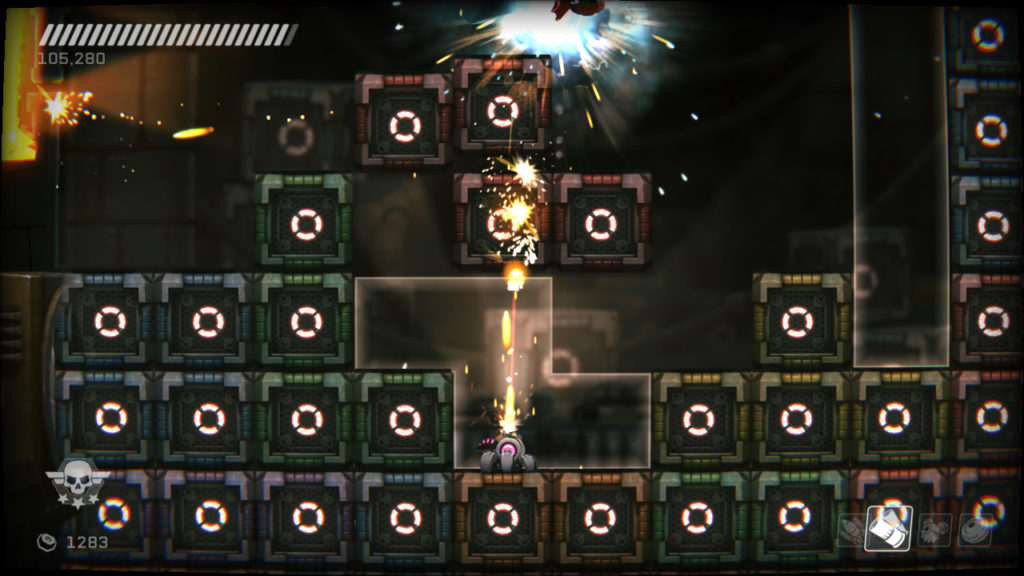
It’s easy to label RIVE as a sidescrolling action platformer, but such a label carries with it a sense of solidity and sterility which bounces off of RIVE because it is a game which so frequently redefines itself so, at the extreme risk of sounding pretentious and overly poetic, I think it is best to continue calling it what I called it earlier – a love letter. But just what sort of a love letter is this? Well, with strings of enemy ships flying in sine wave patterns, giant enemy squids, and explicit references to Parodius, R-Type, and other corridor shooters it’s clearly a love letter to shmups. Yet, you spend the majority of your time here with gravity firmly attached so shmups are not the only games this letter was made for. It’s also a love letter to Action RPG’s and Metroidvanias with all the upgrades to buy, a few exceptionally well-hidden secrets, several conversations, and a single, interconnect map to explore. Of course, this doesn’t entirely fit either as the conversations can almost always be skipped by destroying or walking away from DLL while he’s talking and even though the whole game is interconnected it is actually divided into missions and is entirely linear with Roughshot decided when and where to warp. Bangai-O is another game which is explicitly referenced and the arenas you frequently find yourself fending off waves of enemies in with explosive destruction matches well, but Bangai-O has nothing beyond its arenas while Contra fits well with the more freeform run-and-gun gameplay, the huge bosses, and the crazy set pieces, but it certainly doesn’t lock players into arenas nor does it mix up its platforming to the degree found here. The truth of the matter is that RIVE is a love letter to entire genres, to specific games, to the old and to the new, containing shadows of just about everything while still very much being its own, unique experience, but above all it is a love letter to anyone and everyone with a passion for games.
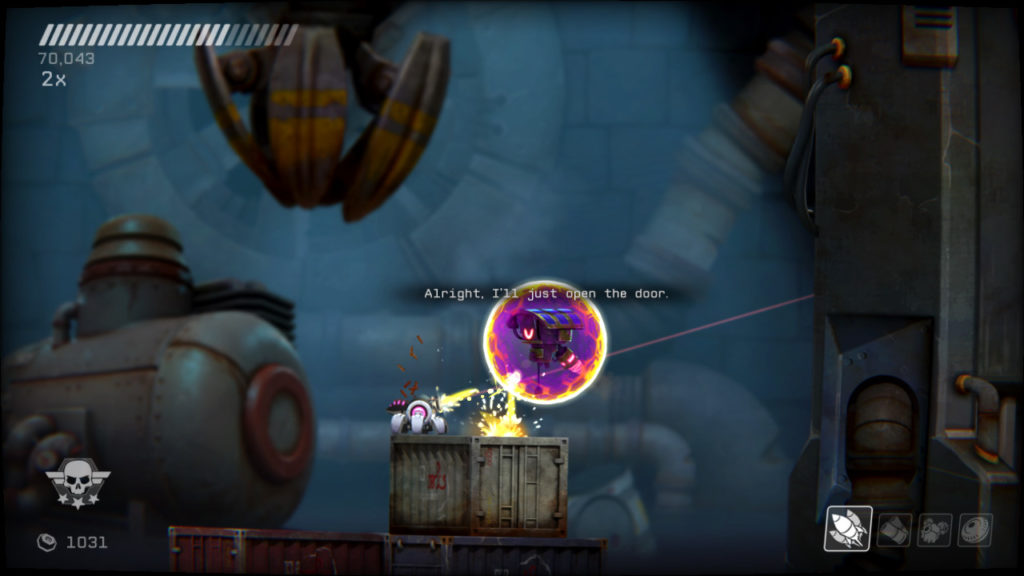
At no point before going in to RIVE did I expect to care all that much about its plot and characters and I even cringed a bit every time Roughshot made a reference to a meme or another game during the first few levels, yet here we are. There’s no way to seriously discuss the plot and themes here without some spoilers and no amount of words will have the same impact as playing the game for yourself, so consider this a spoiler warning and feel free to skip this paragraph and the next one if you plan to play the game for yourself. Initially, Roughshot comes across as a fairly one-dimensional action game protagonist as he shoots his way through hordes of enemies in search of loot, and in a way he is exactly that, while DLL initially comes across as a stereotypical comedic villain along the lines of Wheatley from Portal 2, and in a way he is exactly that. However, after a few hours of Roughshot making references to other games, after fighting your way through hordes of enemies and scenarios which themselves are frequently references to other games, and after hearing DLL mention how he also enjoys games and how his many deadly creations are type of art inspired by these games, at some point everything suddenly clicks – this game has to have so many different types of references to so many other games because it’s a game about games and about those who make and play games.
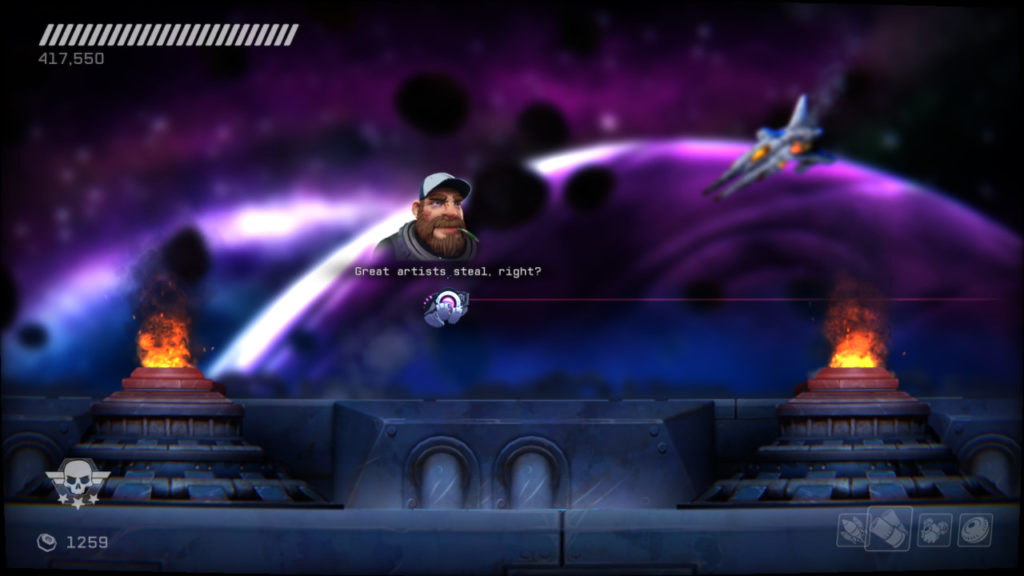
Sure, there is an actual story of sorts, but the ship is ultimately a giant set piece filled with set pieces and DLL and Roughshot are respectively stand-ins for game designers and players. As a designer, DLL takes inspiration from his favorite games to carefully craft chaotic choreographies as he treats his creations as interactive art and he would like nothing more than to receive feedback from Roughshot or to discuss the intricacies of enemy patterns and platforming challenges as he forcibly guides Roughshot along a planned path. Roughshot, in his role as a stand-in for players, can choose to sit around and listen to DLL for a while or to just ignore or destroy him and move on, but he doesn’t care about the more technical details of level design and instead only cares about having fun blowing stuff up and breaking things apart as he tries to forge his own path towards loot or other objectives, though he does sometimes happen to forget just what his current goal even is and gradually begins to grudgingly admit to enjoying DLL’s creations. As an additional symbolic bonus which someone likely was proud to add in and which most players either won’t catch or won’t care much about, the whole game technically takes place from a first-person perspective, directly through the eyes of Roughshot as he has simply switched his external camera to sidescroller view. This is all to say nothing of the ending, which for a few brief moments takes on a surprisingly serious tone to deliver one of the most sincerely heartfelt and honest conversations I’ve ever seen in a game even while staying completely in-character alongside a few more references. Whether you let every conversation play out in full, ignore everything while rushing ahead, or exit out of the campaign to take on challenges, battle arenas, and individual missions for high scores, you, me, and anyone who plays RIVE will be caught up in its narrative because we are helping to create that narrative whenever and however we play it.
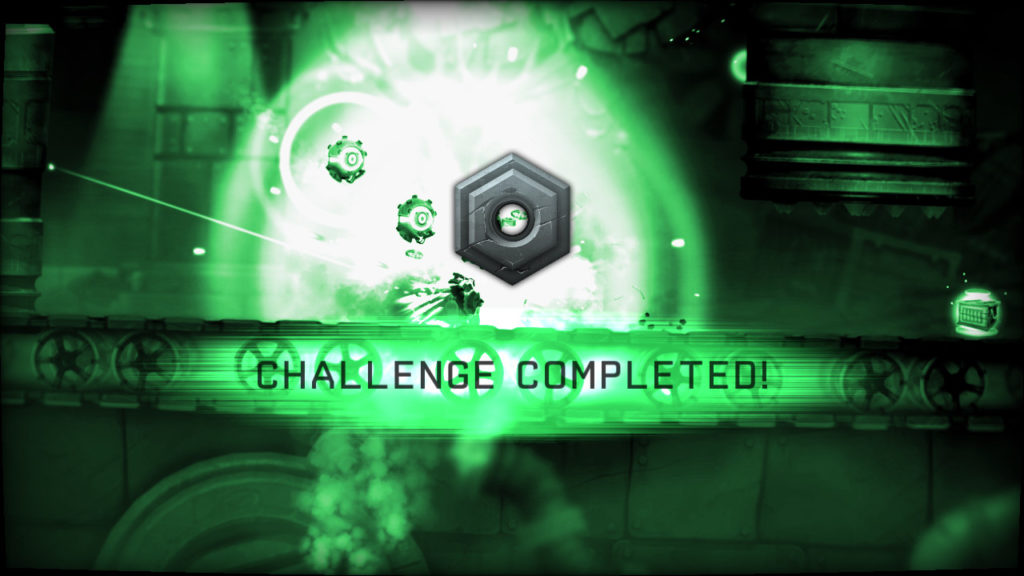
If it sounds like I’m being overly positive towards RIVE, then it’s only because this has been one of the most solid and consistently exceptional games I’ve played in the past year. It has a few issues, but they are so minor as to be virtually negligible. Once or twice a laser appeared to form an arena barrier without enough warning and I died as a result and at one point a platform shot out of a wall and I got stuck in it and had to restart from my last checkpoint, but in both cases I lost a grand total of somewhere around ten seconds, possibly even less. Perhaps the ship moves slightly too fast for some of the hazards near the start of an autoscrolling section in Mission 6? Such complaints pale in comparison to the sheer amount of passion and care bursting forth from every explosive spectacle and the endless number of little, meaningful ways in which the game constantly redefines itself is mesmerizing. RIVE may by a surprising swan song for Two Tribes to go out on, but I’d be hard pressed to think of a more appropriate way for one of my favorite developers to say goodbye.